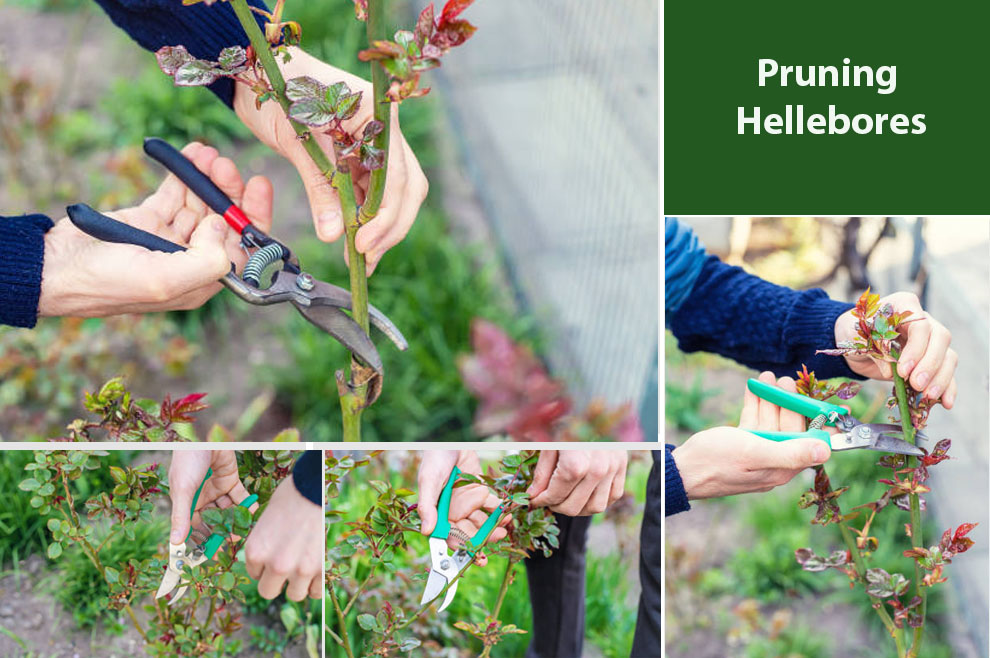Pruning Hellebores Correctly At The Right Time
Always use a sharp tool and prune it during the late winter or early spring

Most Hellebore varieties are evergreen, provided you grow them in the zones where they can survive. So, the last year’s development is still hanging onto the tree when the growth shows. At times, this may be unsightly, but most people find it alluring. Regardless, they are low-maintenance but need a trim down time-to-time. So, you must know how to prune hellebores correctly.
Hellebores are beautiful plants that blossom in late winter or early spring. Also known synonymously as the Lenten or Christmas rose, depending on your chosen variety, they have glossy, large leaves with fresh-dewy pink, white, and bright green blooms that are a pleasant sight in the late winter when not much is happening otherwise in the garden. The plant thrives in USDA zones four through nine.
You can trim the growth before their six to eight-week bloom period starts. It can help you show off your flowers and leave them looking fresh across the year. You will also see some vegetation looking tattered in the winter months. Hence, pruning hellebores can help eliminate the damaged, unpleasant foliage and make your Hellebores look fresh around the year.
Below, we will discuss everything you must know about pruning the hellebores, the tools required, and the pruning method. Let us discuss each of these aspects one by one below.
Why To Prune Hellebores?
Pruning is necessary to keep the plant healthy and thriving. Getting rid of dead foliage allows the greener parts of the plant to get all the nutrients. When new growth emerges, late winter or early spring is the perfect time to prune your hellebore plant. You will see the new growth from the earth as a little stalk, and the stalks will be encircled by a ring of the large leaves from the past year’s growth.
You might find the old growth somewhat withered by the cold weather, making it appear worn down. Hence, trimming hellebores is advantageous.
Ideally, you can trim the new growth when you see the new growth by merely chopping the damaged older foliage from the base. But please note to prune only the unhealthy and damaged leaves. However, your plant should have room for the new growth to leaf out.
Hence, systematically pruning hellebores can help. If you wait too long to conduct the pruning activity, the new growth will start tangling with the older growth restricting air circulation within the plant. Pruning is also recommended because without it the plant is susceptible to an attack from slugs and snails, and the thick foliage gives them a comfortable, wet hiding space.
Tools Needed for Lenten Rose Pruning

Here are some tools you need for pruning hellebore variety:
- A good set of hand pruners
- A stout looper
- A folding saw
- A rake and a shovel
- Plastic horse feed bucket
Extra tools (optional)
- Steel soil scoop
- Diamond sharpener
How To Prune Hellebores: A Step-By-Step Guide

Step 1 – Start with the dead foliage
1. Get the proper pruning tools handy – Get access to hand pruners that are sharp and good. Trimming pruners with a scissor action work best. Since Hellebores are toxic, you must wear gloves. Gloves can also guard you against the thorns.
2. Consider pruning hellebores in mid-winter – You must wait until mid-winter before you can start pruning your plants. It is the time when new flower beds develop. So, cut the old foliage off the base making the plant seem unsightly. Excessive old leaves on the plant put it at risk of fungal sores and bacterial infection. So, make way for the new leaves to grow from the center, where they will open and spread as they grow.
3. Continue cutting the hellebores if you see any dead or damaged parts across the growing season – With the progression of the season, even some new leaves might seem tattered. You can prune them anytime during the growing season. It leaves your plant looking tidy and neat.
4. Perform lenten rose pruning for the diseased parts if any diseased growth shows – You must immediately eliminate the diseased parts on the plant to stop the disease spread. Also, when you trim or remove the diseased growth, you can put it in a trash bag or burn it instantly. Never put the diseased foliage in the compost container because that may spread diseases.
After you finish pruning hellebores, wash the pruning tools with soap and hot water to prevent them from spreading the disease in the following use.
Step 2 – Tackle the dead flowers
1. Deadhead the flowers – Once you have decided to grow hellebores, you need to prevent unwanted seedlings. You can prune the flowers immediately after they start dying or fading. This method of cutting back hellebores is known as deadheading. It enables the plant to conserve energy and put it towards the new blooms instead of trying to keep the older ones alive.
You need to chop the stems off at the base. After pruning, any leftover flower left on the plant will start dropping seeds in the soil, resulting in new seedlings emerging from the parent plants in the spring.
2. Manage the seedlings – Let the seedlings from the dropped seeds of the previous season grow. But please be careful as you dig and leave enough space between the two to avoid overcrowding.
3. Propagate the seeds in a greenhouse – When trimming hellebores, if you extract the seeds, you can store them for growing in the greenhouse.
When To Prune It?
Ideally, the most suitable time for hellebore pruning is between late winter and early spring. Typically, it should be immediately after the new growth shows. Even if you know how to trim hellebores, you should start by examining the new growth. It must be stemming straight from the ground, resembling little stalks. Now, go ahead, and trim back all the leaves that seem dried, dead, or infected.
Further, trim any foliage with diseases or insect damage. Pruning hellebores is an essential step to ensuring that your plant looks green and thriving. When pruning, stay cautious, and cut back only the damaged or dead foliage and not any flower streams or flower buds by mistake. A well-done job at lenten rose pruning can ensure that your landscape has colors even during the winter.
Frequently Asked Questions
Ques 1. When should hellebores be cut back?
Ans. Knowing how to cut back hellebores is one thing and doing it at the right time is another. November is the most suitable time for cutting back the hellebores. Cut off last year’s foliage at the end of the season to avoid leaf spot diseases carried through the winter on the infected leaves and flowers.
Ques 2. Can I prune hellebores in summer?
Ans.Hellebores are forgiving and do not mind a little tidying across the year. During the summer months, the hellebores are in dormancy. Hence, you do not have to water them, but pruning hellebores can be beneficial. Trimming is a part of the routine hellebores care.
So, even though they grow primarily in spring and winter, pruning during summer can help. However, hellebores do not need heavy upkeep in the summertime. Merely pruning and cutting back hellebores can suffice. Every other maintenance is only optional.
Ques 3. Can you cut hellebores back to the ground?
Ans.Your aim should be to cut as close to the ground as possible. However, be careful while pruning, as the sap can irritate the skin. You can wear gloves when doing the pruning.
Ques 4. Do Overgrown hellebores create a problem?
Ans. As long as the foliage looks healthy, you do not have to prune them. But, it is imperative to create space for new growth. If you do not prune older growth, the fresh produce will entangle the older one, making circulation difficult. So, perform strategic lenten rose pruning.
Summing Up…
So, this is all about pruning the hellebores. Do it at the right time to reap maximum benefits and healthy growth.
